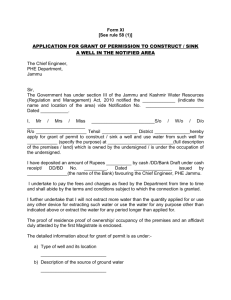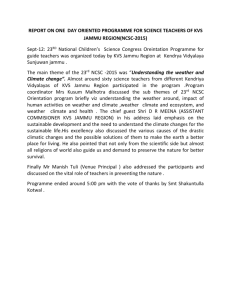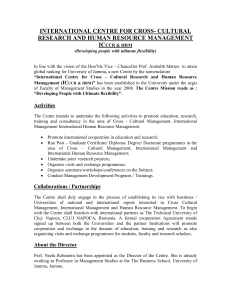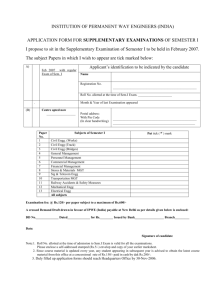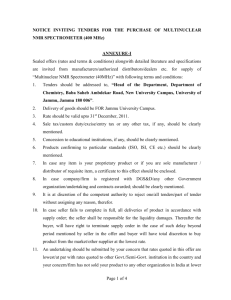2 40
advertisement
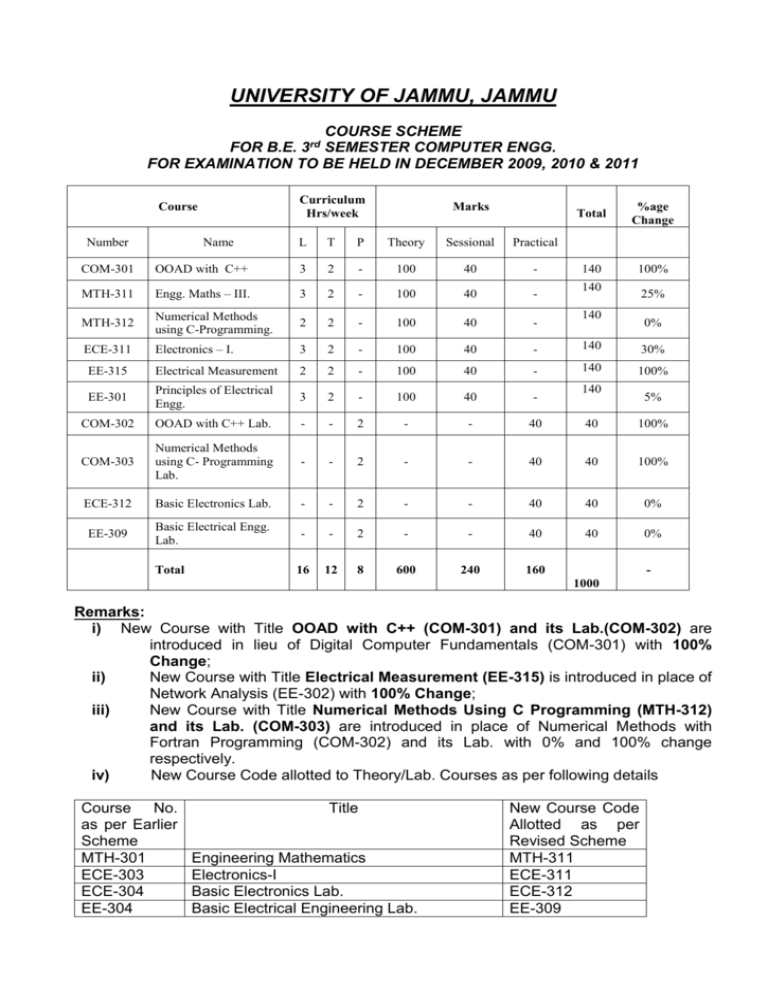
UNIVERSITY OF JAMMU, JAMMU COURSE SCHEME FOR B.E. SEMESTER COMPUTER ENGG. FOR EXAMINATION TO BE HELD IN DECEMBER 2009, 2010 & 2011 3rd Curriculum Hrs/week Course Number Name Marks L T P Theory Sessional Practical Total %age Change 140 100% COM-301 OOAD with C++ 3 2 - 100 40 - MTH-311 Engg. Maths – III. 3 2 - 100 40 - MTH-312 Numerical Methods using C-Programming. 2 2 - 100 40 - ECE-311 Electronics – I. 3 2 - 100 40 - 140 30% EE-315 Electrical Measurement 2 2 - 100 40 - 140 100% EE-301 Principles of Electrical Engg. 3 2 - 100 40 - COM-302 OOAD with C++ Lab. - - 2 - - 40 40 100% COM-303 Numerical Methods using C- Programming Lab. - - 2 - - 40 40 100% ECE-312 Basic Electronics Lab. - - 2 - - 40 40 0% EE-309 Basic Electrical Engg. Lab. - - 2 - - 40 40 0% 16 12 8 600 240 160 Total 140 25% 140 0% 140 5% 1000 Remarks: i) New Course with Title OOAD with C++ (COM-301) and its Lab.(COM-302) are introduced in lieu of Digital Computer Fundamentals (COM-301) with 100% Change; ii) New Course with Title Electrical Measurement (EE-315) is introduced in place of Network Analysis (EE-302) with 100% Change; iii) New Course with Title Numerical Methods Using C Programming (MTH-312) and its Lab. (COM-303) are introduced in place of Numerical Methods with Fortran Programming (COM-302) and its Lab. with 0% and 100% change respectively. iv) New Course Code allotted to Theory/Lab. Courses as per following details Course No. as per Earlier Scheme MTH-301 ECE-303 ECE-304 EE-304 Title Engineering Mathematics Electronics-I Basic Electronics Lab. Basic Electrical Engineering Lab. New Course Code Allotted as per Revised Scheme MTH-311 ECE-311 ECE-312 EE-309 UNIVERSITY OF JAMMU, JAMMU COURSE SCHEME FOR B.E. 3rd SEMESTER COMPUTER ENGG. FOR EXAMINATION TO BE HELD IN DECEMBER 2009, 2010 & 2011 Curriculum Hrs/week Course Number Name Marks Total L T P Theory Sessional Practical COM-301 OOAD with C++ 3 2 - 100 40 - MTH-311 Engg. Maths – III. 3 2 - 100 40 - MTH-312 Numerical Methods using C-Programming. 2 2 - 100 40 - ECE-311 Electronics – I. 3 2 - 100 40 - 2 2 - 100 40 - 3 2 - 100 40 - EE-315 EE-301 Electrical Measurement Principles of Electrical Engg. 140 140 140 140 140 140 COM-302 OOAD with C++ Lab. - - 2 - - 40 40 COM-303 Numerical Methods using C- Programming Lab. - - 2 - - 40 40 ECE-312 Basic Electronics Lab. - - 2 - - 40 40 EE-309 Basic Electrical Engg. Lab. - - 2 - - 40 40 16 12 8 600 240 160 1000 Total UNIVERSITY OF JAMMU, JAMMU FOR EXAMINATION TO BE HELD IN DECEMBER 2009, 2010 & 2011 CLASS: B.E 3RD SEMESTER BRANCH: COMPUTER ENGINEERING, INFORMATION TECHNOLOGY COURSE TITLE: OOAD with C++ Course No. COM –301 DURATION OF EXAM: 3 HOURS L T MARKS 3 2 Theory 100 Sessionals 40 SECTION-1 1. Review of Pointers: Passing parameters, Array of Pointers, Character Pointers. Programming Techniques: Unstructured, Procedural, Modular. Introduction to objects, object & cohesion (30) 2. Overview of C++, Object Oriented programming, Encapsulation, Polymorphism, Inheritance, Console I/O, C++ Comments. Classes, Metaclass, Abstract class, Public and private variables, Constructor and Destructor Functions, Constructors taking parameters, Object pointers, In-Line Functions, Automatic Inlining, Friend Functions, This Pointer, New & Delete, Array of Objects. (50) SECTION-II 1. Function Overloading, Overloading Constructor Functions, Operator overloading, Overloading Binary and Unary Operators, Overloading Relational & logical Operators. (30) 2. Inheritance, Using Protected Members, multiple inheritance, Virtual Base Classes, Introduction to Virtual Functions. (30) 3. C++, I/O Basics, Ifstream, Ofstream, Fstream, Open(), Close(), EOF(), Binary I/O, Get(), Put(), Read(), Write(), Random Access, Seekg(), Seekp(), Tellg(), Tellp(). (20) BOOKS RECOMMENDED: 1. Turbo C++ -by Robert Lafore. Reference Books: 1. Programming in C++ - by Balaguruswamy. 2. C++ the Complete Referance – by Herbert Schildt. 3. Mastering C++ - by K.R. Venugopal & T. Ravishankar & Raj Kumar. NOTE: There shall be total Eight Questions of 20 marks each, Four questions from each section and students have to attempt Five questions selecting at least Two from each section. Use of Calculator is allowed UNIVERSITY OF JAMMU, JAMMU FOR EXAMINATION TO BE HELD IN DECEMBER 2009, 2010 & 2011 CLASS: B.E. 3RD SEMESTER BRANCH: COMPUTER ENGINEERING COURSE TITLE: NUMERICAL METHODS USING C- PROGRAMMING. Course No. MTH-312 DURATION OF EXAM: 3 HOURS L T MARKS 2 1. 2. 2 Theory Sessionals 100 40 SECTION – I Fortran Programming: - Introduction to data types, Constants, variables, Expressions, Statements, Operators, Control Statements, Array, Functions and Sub-routines. (20) Errors and significant digits: - Computer representation of numbers, accuracy of numbers, Errors, Errors in approximation. Roots of algebraic equations: - Bisection methods, Secant methods, Newton Raphson Method, Integrated synthetic division with quadratic factors, method for finding complex roots, Graeffe’s Root squaring method. (30) 3. Solution of simultaneous algebraic equations :- Gauss Elimination, Gauss Jordan, Partition method for linear system of equations, Power method for finding Eigen values, properties & bounds for Eigen values & Eigen vectors. (30) SECTION – II 1. Interpolation: - Newton’s Forward, Backward & Divided difference interpolation, Central difference interpolation formula, Stirling’s & Bessel’s formula, Langrange’s interpolation formula. (20) 2. Numerical Differentiation & Integration:- Derivatives using Forward Difference Formula, Backward difference formula & Central difference formula, Numerical Integration using Trapezoidal Rule & Simpson’s Rule (30) 3. Difference equations & their solutions: - Taylor’s series method, Euler’s method, Ranga kutta method, Predictor – Corrector method, Adams –Bashforth method (30) BOOKS RECOMMENDED 1. Elementary Numerical Analysis- S.D. Conte & Carl De Boor., Macgraw hill 2. Numerical Method for Scientists & Engineers- M.R. Jain ,S.R.K. Iynegar & R.K Jain.,Wiley Eastern 3. Elementary Numerical Methods – B.S. Grewal, Knanna Publishion. NOTE: There shall be total Eight Questions of 20 marks each, Four questions from each section and students have to attempt Five questions selecting at least Two from each section. Use of Calculator is allowed. UNIVERSITY OF JAMMU, JAMMU FOR EXAMINATION TO BE HELD IN DECEMBER 2009, 2010 & 2011 CLASS: B.E 3RD SEMESTER BRANCH: COMPUTER ENGINEERING COURSE TITLE: ELECTRONICS - I. Course No. ECE-311 DURATION OF EXAM: 3 HOURS L 3 T MARKS 2 Theory Sessionals 100 40 UNIT – I Semiconductor devices: - Introduction, Intrinsic and extrinsic Semiconductors, PN- Junction Diodes, Mass Action Law, Diffusion and Drift with derivation, Zener Diode, Tunnel diode, Schottky Diode, Photo diode, LED’s – Their characteristics and analysis, Hall effect. UNIT – II Transistors: Transistor and its characteristics in CE, CB & CC mode, Ebber’s Moll Model, Generalized transistor Equation, Base width modulation, Biasing Ckt.., for transistors, CB,CC & CE configuration, FET’s and their analysis, Operating point and load line, Characterstics and Equivalent Ckts. of JFET, MOSFET, UJT, PNPN Devices ( Thyristor Family). UNIT – III Amplifiers: principle of Operation and classification of Amplifiers, H- Parameters, BJT & FET, Analysis and Frequency Response of Amplifiers, Multistage Amplifiers RC, LC, DC and transformer coupled. UNIT – IV Hybrid II Model: Gain band width product, Emitter follower at High Frequency Response of CE Amplifiers, Miller effect, Common Drain Amplifier at high frequencies. Reference Books :1. Electronic Principles – by Malvin; 2. Integrated Electronics – by Millman & Halkias; Tata McGraw Hill Tata McGraw Hill NOTE: There shall be total Eight Questions of 20 marks each, Two from each Unit and students have to attempt Five questions selecting at least One from each Unit. Use of Calculator is allowed. UNIVERSITY OF JAMMU, JAMMU FOR EXAMINATION TO BE HELD IN DECEMBER 2009, 2010 & 2011 CLASS: B.E 3RD SEMESTER BRANCH: COMPUTER COURSE TITLE: ELECTRICAL MEASUREMENT Course No. EE- 315 DURATION OF EXAM: 3 HOURS L T 2 2 MARKS Theory Sessionals 100 40 Unit-I Measurement & Error: - Measurement, significance of measurement, Methods of measurements, Instrumentation & their classifications, Sensitivity, resolution, accuracy, precision, significant figures, absolute and relative errors, types of errors, limiting errors, linearity & probability of errors. Unit-II Analog & Digital Instruments: - Analog multimeter as voltmeter, ammeter & ohmmeter, Electronic multimeter, voltmeters & ammeters for measurement of a.c. currents & voltages, thermo instruments, True RMS responding voltmeter. Digital multimeter as voltmeter, ammeter & ohmmeter, Digital L.C.R measurements, Digital frequency meter, ratio measurement, period measurement, Time Interval measurement. UNIT-III Bridge Measurements :- Wheatstone bridge, Kelvin bridge, AC bridges, Maxwell, Hays Bridge, Schering bridge, Wagner Ground connection, Wein bridge Unit-IV Oscilloscopes:-Block diagram ,CRT, probes, deflection amplifiers & delay line, source & coupling for trigger generator, automatic time base, Dual trace oscilloscope, sweepmode measurements of voltage, phase, frequency , dual beam oscilloscopes Unit -V Transducers & data acquisition systems:- Classification of transducers, selecting a transducer, strain guages, Displacement ,temperature measurements, photosensitive devices Introduction, Block diagram representation, Recorders, necessity of recorders, Recording requirements, classification of recorders. References: 1. A Course in Electrical & Electronic Measurement & Instrument.( Dhanpati ) – A.K. Sawhney. 2. Electrical Measurement & Measuring Instruments ( ELBs) – F.W. Golding. 3. A course in Electrical & Electronic Measurement & Instrumentation – J.B. Gupta. NOTE: There shall be total Eight Questions of 20 marks each. Students have to attempt Five questions selecting one from each Unit. UNIVERSITY OF JAMMU, JAMMU FOR EXAMINATION TO BE HELD IN DECEMBER 2009, 2010 & 2011 CLASS: B.E 3RD SEMESTER BRANCH: COMPUTER COURSE TITLE: MATHEMATICS – III COURSE No. MTH-311 DURATION OF EXAM: 3 HOURS L 3 T MARKS 2 Theory Sessionals 100 40 SECTION - I LAPLACE TRANSFORMS: Laplace Transforms, Inverse Laplace Transforms, Properties of Laplace Transforms, LT of unit step function, Impulse function, Periodic function, Initial value theorem, Final value theorem, Convolution theorem, Application of LT to solve linear differential equations and convolution type integral equations. INTEGRAL TRANSFORMS AND FOURIER INTEGRALS: Integral transforms and Fourier Integrals Fourier integral theorem, Fourier sine and cosine Integrals, and their inverses. SECTION - II SPECIAL FUNCTIONS: Special Functions Legendre polynomials, Rodgrigue’s formula, Recurrence formulae, generating function, Orthogonality of Legendre polynomials, Bessel function of Ist kind. Recurrence formulae, generating function, Orthoganality of Bessel function. BOOLEAN ALGEBRAS: Boolean Algebras, Lattices, Finite Boolean algebra, C.N.F and D.N.F, Application of Boolean algebra to switching theory. Books Recommended:01. Higher Engineering Mathematics 02. Boolean Lattices 03. Engineering Mathematics-III B.S. Grewal V.K. Khanna Bhopinder Singh NOTE: There shall be total Eight Questions of 20 marks each, Four questions from each section and students have to attempt Five questions selecting at least Two from each section. Use of Calculator is allowed. UNIVERSITY OF JAMMU, JAMMU FOR EXAMINATION TO BE HELD IN DECEMBER 2009, 2010 & 2011 CLASS: B.E 3RD SEMESTER BRANCH: COMPUTER COURSE TITLE: PRINCIPLES OF ELECTRICAL ENGG. Course No. EE-301 DURATION OF EXAM: 3 HOURS L T 3 2 MARKS Theory Sessionals 100 40 UNIT – I Electric circuit laws & energy sources: Basic electric circuit Terminology, Ohm’s law, Kirchoff’s current law (KCL) & Kirchoff’s Voltage law (KVL), Circuit parameters, (Resistance, Inductance & Capacitance), series & parallel combination of resistance, Inductance & Capacitance, Ideal & practical voltage and Current sources and their transformation, Dependent voltage sources & Dependent current Sources. UNIT – II D.C Circuit Analysis: - power & energy relations, analysis of series Parallel D.C Circuit, delta –Star transformation, Superposition theorem, Loop & Nodal Methods, Thevenin’s theorem, Norton’s Theorem, Maximum Power Transfer Theorem UNIT – III A.C. Circuit Analysis: basic terminology and definition, Phasor And Complex Number Representation, Solution of Sinusoidally Excited RLC circuits, Formulation of N/W Equation, Laplace transform equation, Power and energy relations in AC ckts, Applications of N/W theorem to AC ckts. , Resonance in series and parallel ckts., quality factor . UNIT -IV Steady state AC 3 phase ckts.:- Concept of 3 phase voltage , Wye (Y) circuits , Delta circuits , current and voltage relations in Wye and delta ckts , Transformer: Construction, Operating principles of Phasor Diagrams. Books Recommended: 1. Basic Electrical Engg. 2. Principles of Electrical Engg 3. Engg. Circuits and Analysis - Fitzgerald Vincent Del Toro Hayt , Kimmerly NOTE: There shall be total Eight Questions of 20 marks each, Two from each Unit and students have to attempt Five questions selecting at least One from each Unit. Use of Calculator is allowed. UNIVERSITY OF JAMMU, JAMMU FOR EXAMINATION TO BE HELD IN DECEMBER 2009, 2010 & 2011 CLASS: B.E 3RD SEMESTER BRANCH: COMPUTER ENGG , INFORMATION TECHNOLOGY COURSE TITLE: OOAD with C++ Lab. COURSE NO. COM-302 L T P MARKS 2 40 The Practicals will be based on Computer Languages Theory Syllabus. The students are required to submit at least 10 Programs covering at least 2 programs from each unit. UNIVERSITY OF JAMMU, JAMMU FOR EXAMINATION TO BE HELD IN DECEMBER 2009, 2010 & 2011 CLASS: B.E 3RD SEMESTER BRANCH: COMPUTER ENGG COURSE TITLE: Numerical Methods using C-Programming lab Course No. COM-303 L T P 2 MARKS 40 The Practical’s will be based on Theory Course in Numerical methods. The students are required to submit/perform at least Ten Programs. UNIVERSITY OF JAMMU, JAMMU FOR EXAMINATION TO BE HELD IN DECEMBER 2009, 2010 & 2011 CLASS: B.E 3RD SEMESTER BRANCH: COMPUTER ENGG COURSE TITLE: Basic Electronics Lab. Course No. ECE-312 L T P 2 MARKS 40 List of Practicals:1) Familiarization with various Electronic components – resistors, Capacitors, Transistors, Diodes, IC, Transformers. 2) Diode characteristics (Forward & Reverse) 3) Diode as a Rectifier with capacitor Filter (Half & Full Bridge) 4) Zener diode Characteristics & Zener diode as voltage regulator. 5) Characteristics of Tunnel Diode, LED's, Photo -diode. 6) Characteristics of transistors in CB, CE & CC mode. 7) Biasing of CE-configuration with Load line characteristics. 8) Characteristics of JFET, MOSFET. 9) Characteristic s of UJT & its working as relaxation oscillator. 10) Characteristic of SCR UNIVERSITY OF JAMMU, JAMMU FOR EXAMINATION TO BE HELD IN DECEMBER 2009, 2010 & 2011 CLASS: B.E 3RD SEMESTER BRANCH: COMPUTER ENGG COURSE TITLE: Basic Electrical Engg. Lab Course No. EE- 309 L (1) (2) (3) (4) (5) (6) (7) (8) (9) T P 2 MARKS 40 Study of wires and cables. Study of various types of wiring. Methods of Earthing & Measurement of Earth resistance. Electric Shocks- Precaution & treatment. Verification of Kirchhoff’s Law. Verification of Superposition Theorem. Study of voltage current relationship of a series RLC circuit & obtain Series Resonance. Study of three phase AC circuit with i) Star connection Load. ii) Delta connected load. Study of Single Phase Transformer. Determination of voltage Ratio, Turn ratio and Polarity test. UNIVERSITY OF JAMMU, JAMMU COURSE SCHEME FOR B.E. 4TH SEM COMPUTER ENGG. FOR EXAMINATION TO BE HELD IN JUNE 2010, 2011 & 2012 Curriculum Hrs/week Course Number Name L T P Theory Sess. COM-401 Digital Electronics. 3 2 100 40 COM-402 Principles of Programming Languages 3 2 100 40 COM-403 MTH-413 ECE-411 System Programming. 3 2 100 3 2 100 40 Electronics – II. 2 2 100 40 140 140 30% 30% 140 100% 140 10% 140 30% 140 Communication Engg. COM-404 Digital Electronics Lab. 2 40 40 0% COM-405 PC Hardware & Maintenance Lab. 2 40 40 100% ECE-413 Electronics – II Lab. 2 40 40 ECE-414 Communication Engg. Lab. 2 40 40 160 1000 16 12 100 TOTAL ECE-412 Total 2 Practical 40 Discrete Mathematics. 2 % age Change Marks 8 600 40 240 30% 20% 100% Remarks: (i) New Course with Title Principles of Programming Language (COM-402) is introduced in place of Computer Language (COM-402) with 30% Change; (ii) New Course with Title System Programming (COM-403) in place of Electrical Measurements and Instrumentation (EE-403) with 100% Change and PC Hardware and Maintenance Lab. in place of Computer Language Lab.(COM-404) with 100% Change. (iii) New Course Code allotted to Lab. Courses as per following details: Course No. as per Earlier Scheme MTH-403 ECE-408 ECE-402 ECE-403 COM-403 -- Title Discrete Mathematics Electronics-II Communication Engineering Electrionics-II Lab. Digital Electronics Lab. New Course Code Allotted as per Revised Scheme MTH-413 ECE-411 ECE-412 ECE-413 COM-404 Communication Engineering Lab. ECE-414 UNIVERSITY OF JAMMU, JAMMU COURSE SCHEME FOR B.E. 4TH SEM COMPUTER ENGG. FOR EXAMINATION TO BE HELD IN JUNE 2010, 2011 & 2012 Curriculum Hrs/week Course Number Name L T P Marks Theory Sessional Practical TOTAL COM-401 Digital Electronics. 3 2 100 40 COM-402 Principles of Programming Languages 3 2 100 40 COM-403 System Programming. 3 2 100 40 Discrete Mathematics. 3 2 100 40 ECE-411 Electronics – II. 2 2 100 40 ECE-412 Communication Engg. 2 2 100 40 COM-404 Digital Electronics Lab. 2 40 40 COM-405 PC Hardware & Maintenance Lab. 2 40 40 ECE-413 Electronics – II Lab. 2 40 40 ECE-414 Communication Engg. Lab. 2 40 40 160 1000 MTH-413 Total 16 12 8 600 240 140 140 140 140 140 140 UNIVERSITY OF JAMMU, JAMMU FOR EXAMINATION TO BE HELD IN DECEMBER 2009, 2010 & 2011 CLASS: B.E.4TH SEMESTER BRANCH: COMPUTER ENGINEERING COURSE TITLE: DIGITAL ELECTRONICS. Course No. C0M-401 DURATION OF EXAM: 3 HOURS L 3 T 2 MARKS Theory Sessionals 100 40 Unit -I Introduction: -, Review of Boolean Algebra, Logical gates, Evaluation of logical expressions, De Morgan’s theorem, Theorem on commutation, Association and Distribution, Representation and minimization of Boolean expressions, Logic Family & their specifications (TTL, ECL, MOS & CMOS) (20) Unit-II Number System and codes: - Introduction, Number systems, conversion between number systems, arithmetic operations using number systems, 1’s Compliment & 2’s Compliment. BCD codes, Excess- 3-code, Grey codes, Conversion between codes, Codes for error detection and correction. (30) Unit-III:Combinational Logic design:-Combination logic design using Gates, Simplification of Boolean functions using K-Maps,Quine MC- Dusky Methods, Patrick’s Methods, Design of various arithmetic ckts., Design of Multiplexer, De-Multiplexers, Decoders, Encoders, Compactors, Design of TSegment Display. (40) Unit-IV:Sequential logic design: - Latches and Flip flops, conversion between flip flops, Shift Registers, Counters, Design of Synchronous and Asynchronous Sequential circuits. (40) Unit- V:Programmed logic design :-Introduction, Programmable Read only Memories (PROM) and Programmable Logic Arrays (PLA), Programmable Array Logic (PAL), Algorithmatic State machines (ASM) Charts, Design Us8ing ASM Charts, Microgram Controller, Register transfer Language (RTL), Analog to digital converter (ADC), Digital to Analog converter (DAC). (30) BOOKS RECOMMENDED: 1. Digital Electronics R.P Jain 2 Digital Logic Design J.P. Hayes 3. Digital Logic Design Brain Holdsworth 4. Digital Design Morris Mano 5. Digital Electronics & Circuits Design Thomas Mac calla 6. Digital Electronics R.K Gour NOTE: There will be Eight question of 20 Marks each as per weight age indicated against each Unit. Students have to attempt Five Questions in all. UNIVERSITY OF JAMMU, JAMMU FOR EXAMINATION TO BE HELD IN JUNE 2010, 2011 & 2012 CLASS: B.E.4TH SEMESTER BRANCH: COMPUTER ENGINEERING COURSE TITLE: PRINCIPLES OF PROGRAMMING LANGUAGES. Course No. C0M-402 DURATION OF EXAM: 3 HOURS L T 2 MARKS 2 Theory 100 Sessionals 40 UNIT –I Programming language concepts: - History, Structure and operation of a Computer, translators and software simulated Computers, Hardware, Software, firmware and virtual Computers, Hierarchies. Data types:- Elementary data types, Specification and implementation, declaration, type checking and type conversion, Assignment and initialization, structured data types, specification and implementation, declaration, Type checking, vectors, Arrays, Character strings, pointers & files. (40) UNIT-II Data and Sequence Control:- Static and dynamic scope, Local data, parameters, Parameter transmission, task shared data, implicit, explicit sequence central, subprogram sequence control, recursive subprograms, exceptions and exception handlers, co-routines , task and concurrent execution. (30) UNIT—III Object Oriented Programming and Operating Environment:- Definition of OOP, difference between procedural and OOP, data encapsulation, data abstraction, information hiding, classes in C++, inheritance and polymorphism in C++, batch processing, interactive, embedded system and programming environment. (30) UNIT—IV Storage, Syntax and Translation:- Programmer and system control, storage management phases, static storage management, stack storage management, heap/storage management in case of fixed and variable size, syntactic criteria, elements of language, stages in translation, formal definition of syntax. Introduction to Lisp & Prolog. (60) BOOKS RECOMMENDED: 1. Programming Languages 2. Programming Languages : : Pratt Pratt & Zelkawitz REFERENCE BOOKS:1. Programming Languages : 2. Programming Languages : 3. Principles of Programming Language: E.Horowitz M.Jazayeri D.Tennett. NOTE: There will be Eight question of 20 Marks each as per weight age indicated against each Unit. Students have to attempt Five Questions in all. UNIVERSITY OF JAMMU, JAMMU FOR EXAMINATION TO BE HELD IN JUNE 2010, 2011 & 2012 CLASS: B.E.4TH SEMESTER BRANCH: COMPUTER ENGINEERING COURSE TITLE: SYSTEM PROGRAMMING Course No. C0M-403 DURATION OF EXAM: 3 HOURS L T 3 2 MARKS Theory Sessionals 100 40 UNIT-I Introduction to Software Processors: - What is system software? Components of system software, Evolution of system software, The Model of computer system Translators, Loaders, Interpreters. (20) UNIT-II Assemblers:- Element of Assembly language programming overview of assembly process, Design of Two-pass Assembler. A single pass Assembler, Macros and Macro processors, Macro calls within Macros. (30) UNIT-III Software processors for interactive Environment:- Interactive Computing and program Development, Interpreters. Incremental compilers. (20) UNIT-IV Loaders and Linkage Editors:-General loader scheme, Compile and go loader, Absolute loader, relocating loader, Loading, Linking and relocation, program Relocatability overview of linkage Editing, A linkage editor for the IBMPC. (40) UNIT-V. Software tools:-Spectrum of software Tools, Text Editors, Interpreters and program Generators, Debug Monitors, programming Environments. (20) UNIT-VI Features of Higher level languages (HLL):- Extensive data types and structures, Scope rules, Storage Allocation, Functional Modularity. (15) UNIT—VII. Compilers:-General Model, Introduction to various phases of compiler. Introduction to Parser and Parsing Techniques. (15) BOOKS RECOMMENDED : 1. System programming and operating systems :by Dharmdhere. D.M. TMH 2. Introduction of systems software : D. dhere—TMH 3. Systems programming : J.J. Donavan—McGraw Hill. NOTE: There will be Eight question of 20 Marks each as per weight age indicated against each Unit. Students have to attempt Five Questions in all. UNIVERSITY OF JAMMU, JAMMU FOR EXAMINATION TO BE HELD IN JUNE 2010, 2011 & 2012 CLASS: B.E.4TH SEMESTER BRANCH: COMPUTER ENGG COURSE TITLE: DISCRETE MATHEMATICS. Course No. MTH-413 DURATION OF EXAM: 3 HOURS L T 3 2 MARKS Theory 100 Sessionals 40 SECTION – I SETS, RELATIONS, MATHEMATICAL LOGIC 1. Finite and infinite sets, countable and uncountable sets, 2. Principle of inclusion and exclusion, Mathematical Induction, Pigeon-Hole principle. 3. Logical operators, truth tables, Law of inferences and prepositional calculus. ALGEBRAIC SYSTEM 1. Relations and functions, types of functions, Lattice, chains, Anti chains 2. Groups and sub groups, Related theorems, cosets, normal subgroups and group Homomorphism 3. Rings, integral domains and fields; examples and related results. SECTION - II GRAPH THEORY 1. Basic terminology, multi graphs and weighted graphs, connectivity ; walk, trail and path, circuits & Cycles, shortest path in weighted graphs, Algorithm of shortest path, 2. Hamiltonian and Eulerian paths and circuits, Eulerian trail & circuit, Eulerian graphs, Hamiltonian cycle, Hamiltonian graph, Konisberg Bridge problem, Chineese Postman problem, Traveling Sales Person problem, Planar graph and Euler’s formula. 3. Trees and cut sets:- Trees, Rooted Trees, path lengths in rooted trees, prefix codes binary search trees, spanning trees and cut sets. BOOKS RECOMMENDED : 1. 2. 3. Discrete Mathematics by C.L. Liu. Graph Theory by Narsingh Deo Discrete Mathematical structure with applications to computer science by Trembley and Manohar. NOTE: There shall be total Eight questions of 20 Marks each, Four from each Section. Students shall have to attempt Five questions selecting at least two from each Section. Use of calculator is allowed. UNIVERSITY OF JAMMU, JAMMU FOR EXAMINATION TO BE HELD IN JUNE 2010, 2011 & 2012 CLASS: B.E.4TH SEMESTER BRANCH: COMPUTER ENGG COURSE TITLE: ELECTRONICS-II. Course No. ECE-411 DURATION OF EXAM: 3 HOURS L 2 T 2 P 0 Theory 100 Marks Sessional Practical 40 0 SECTION - I FEEDBACK AMPLIFIERS Classification of amplifiers, Feedback concept, Advantages of negative feedback Way of introducing negative feedback in amplifiers, Gain with & without negative feedback , effect of negative feedback on Input & Output resistances of amplifiers. Bandwidth with negative feedback & their analysis. Procedure for analysis of feedback amplifiers, Analysis of different topologies. OSCILLATORS Necessity of oscillator, Barkhussein criteria, Gain with Feedback, Types of Oscillators, Audio frequency(R-C phase shift, Wein bridge) & radio frequency( Collpitt, Clapp, Hartley ) oscillators with necessary derivation for determining gain & frequency of oscillation. Crystal Oscillator. SECTION - II VOLTAGE REGULATORS Necessity of voltage regulated supplies, Factors effecting unregulated power supply, Stabilization, Types of voltage regulators-Series & shunt regulators. Series voltage regulator using emitter follower & its expression for Sv & Ro. Pre regulators, Short Circuit protection circuits, Monolithic regulators , SMPS. . OPERATIONAL AMPLIFIERS & ITS APPLICATION Basic Differential Amplifier- its working & types, Small signal analysis using H-parameters, Differential & Common mode gain, Building block of op-amp, Circuit symbol features & Electrical parameters of OP-Amp, Op-amp in open loop & closed loop configuration with derivation. OP-amp as voltage follower, Inverter, I-V converter, Summing, Scaling & average amplifiers(Non Inverting & Inverting), Op-amp as clipper, clamper, peak detector, comparators & Schmitt trigger,. Integrator, Differentiator, Timer-555 & its Applications. Book Recommended: 01. Integrated Electronics 02. Electronics Devices 03. Electronics Devices 04 Op-Amp & Linear Integrated Circuit By By By By Millman Halkais Bolystead Malvino Leach R.A. Gyakwad. NOTE : There shall be Eight Questions of 20 Marks each, Four from Each Section. Five questions have to be attempted in all selecting at least two from each Section. UNIVERSITY OF JAMMU, JAMMU. For Examination to be held in June 2010, 2011 & 2012 Class: BE 4th Semester Branch: COMPUTER ENGINEERING Course No:- ECE-412 Course Title:- Communication Engg. Duration of Exam: 3 Hours Marks L 2 T 2 P - Theory Sessional 100 40 Practical -- SECTION - I Introduction to Elect. Comm. System, Concept & need for modulation, Definition of signal to noise ratio & noise figure, Representation of signal & system (periodic non-periodic etc.), Spectral analysis of signal (Fourier series & fourier Transforms), Representation of AM. Frequency spectrum of AM wave, Power relation in Am wave, Modulation & demodulation of AM, SSB techniques, Balanced modulator, Type of SSB, Modulation & demodulation of SSB signals. Theory of FM, Representation & frequency spectrum of FM, Pre-Emphasis De-Emphasis, Wide band & narrow band FM, Generation & detection of FM signal, Comparison with PM & AM. SECTION - II Pulse modulation techniques, Sampling & sampling theorem & its proof, Aliasing effect, Natural & flat top sampling principle generation & detection of PAM, PPM, PWM, PCM, DM, ADM, Time division multiplexing, Frequency division multiplexing. Digital modulation Techniques: Generation & detection of ASK,FSK,BPSK. Information Theory: Information , information rate, Entropy ,Source-coding & coding Efficiency , Shannon –Fano coding, huff-man coding, Channel capacity theorem. Books Recommended: 1. Electronics Comm. System 2. Principles of Comm. System By G. Kennedy By. Taub & Schilling Reference Book 1. Communication System By Simon Haykins NOTE : There shall be Eight Questions of 20 Marks each, Four from Each Section. Five questions have to be attempted in all selecting at least two from each Section. UNIVERSITY OF JAMMU, JAMMU FOR EXAMINATION TO BE HELD IN JUNE 2010, 2011 & 2012 CLASS: B.E.4TH SEMESTER BRANCH: COMPUTER ENGINEERING COURSE TITLE: DIGITAL ELECTRONICS LAB. Course No. COM-404 L T P 2 List of Practicals:1. Verification of truth table of basic gates. 2. Verification of truth tables of ADDER/SUBTRACTER using IC-7483 3. Verification of truth tables of MULTIPLEXER/DEMULTIPLEXER 4. Verification of truth tables of BCD –7- Segment Display 5. Verification of truth tables of Code Conversion. 6. Design of Flip-Flops using IC chips. 7. Design of Two’s complementor ckts using shift registers. 8. Design and Implementation of Asynchronous MOD-12 counters. 9. Design of a sequential ckt for character generation 10. Study of PLA'S and PAL's. UNIVERSITY OF JAMMU, JAMMU FOR EXAMINATION TO BE HELD IN JUNE 2010, 2011 & 2012 CLASS: B.E.4TH SEMESTER BRANCH: COMPUTER ENGG MARKS 40 COURSE TITLE: PC HARDWARE & MAINTENANCE LAB. Course No. COM-405 L T P - - 2 MARKS 40 List of Practicals:1. Keyboards – Mechanical Keyboards, Membrane Keyboards, 2. Printers – Dot Matrix, Inkjet Printers. 3. SMPS. 4. the units of Computer,. 5. in the various units of Computer, fault finding Codes and Beeps. 6. loading at different Platforms such as DOS, Windows –95 /98 2000. 7. Antivirus Software. 8. of user Manuals/ Service Manuals for various Computer Blocks. UNIVERSITY OF JAMMU For Examination to be held in June 2010, 2011 & 2012 Study of Study of Study of Assembling Fault Finding Software Use of Preparation Class: BE 4th Semester Branch: Computer Engg. Course No: ECE-413 Course Title: Electronics-II Lab Duration of Exam: 3 Hours L - T - P 2 Practical 40 List of Practicals 1. To study the operation characteristics of the P.N. junction, Ge/Si (Forward & Reverse Charactersitics). 2. To study the operation characteristics of Zener diode (Forward & Reverse Charactersitics). 3. Half wave Rectifier. 4. Full wave / Bridge Rectifier. 5. To study the operation charactersistics (Input / Output) of PNP / NPN Transistor (Common Emitter / Common Base). 6. To study the frequency response of signal amplifier (CE/CB). UNIVERSITY OF JAMMU, JAMMU FOR EXAMINATION TO BE HELD IN JUNE 2010, 2011 & 2012 CLASS: B.E.4TH SEMESTER BRANCH: COMPUTER ENGG COURSE TITLE: COMMUNICATION ENGG. LAB. Course No. ECE-414 L T P - 2 List of Practicals:1. To plot the response of RF Tuned amplifier. 2. To find the modulation index of AM signal. 3. Hardware realization of AM demodulator circuit. 4. Hardware realization of FM modulation circuit using 8038. 5. Hardware realization of Sample & Hold circuit. 6. Hardware realization of Ask modulator. 7. Study of PCM & TDM signals. MARKS 40
